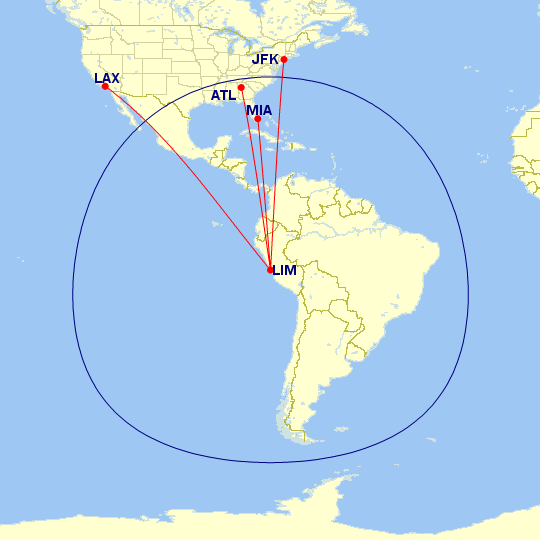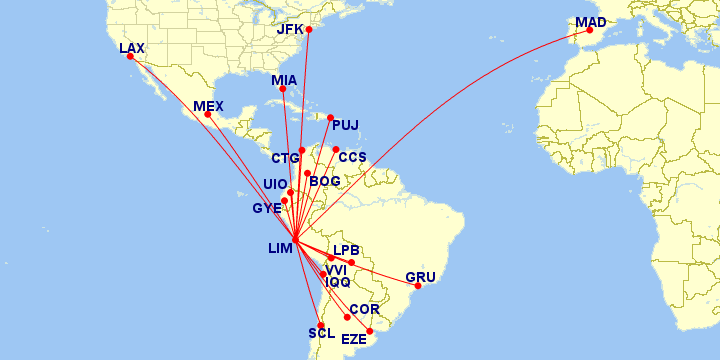Few stories in Latin American aviation have been as succcesful as Copa Airlines’. The airline from Panama has benefitted from its location to become a major player in travel across the Americas.
With Copa, a passenger can hop in Rosario, Argentina and get to Aruba, Havana or San Juan with a short connection in Panama City for usually a low fare. And what is more impressive for the industry — it does so very profitably. For this year, the airline is guiding for an operating margin of 22 to 24%.
This feat has not gone unnoticed to the continent’s major airlines. Avianca has done so for years in its hubs of San Salvador and particularly Bogotá, although the latter has had high slot limitations. Avianca did have smaller operation connecting the Americas through Lima and San Jose, too, albeit these have been all but shut down even before COVID-19 hit.
The other major group in Latin America, LATAM Airlines, has had its Lima hub for a long time. Incorporated in 1999 still as LAN Perú, the hub was started in 2004. By 2009 the Peruvian capital was connected to 15 cities internationally. By December 2008, LAN Perú had a market share of 39% in the international segment from Peru, and a 78% share domestically.
From then on, the hub grew, banking on North-South connections, much as Copa did to the North. Between 2009 and 2019, LAN (now LATAM) grew the number of seats offered from Lima by 164.4%, with ASKs growing by 149.9%, according to data collected by Aviacionline via Cirium.
LATAM’s Lima hub, by 2019, had three clear banks of international connections throughout the day, the three working simultaneously in driving North-South passengers and vice-versa. This was in comparison with Copa’s six very pronounced banks throughout the day.
Also remarkably, Peru has a relatively large domestic market in which LATAM was the largest player. This meant high frequencies to national destinations which also helped driving relevant connectivity; in 2019, practically two thirds of its 98,773 departures to and from Lima were domestic flights.
A year later, however, the COVID-19 pandemic hit. International travel — the core of what made LATAM’s hub a competitive advantage — was virtually halted. This allowed LATAM Airlines Group, which was already starting to see growing low-cost competition in Peru, to review its cost structure. The Peruvian unit was among the first companies included in the group’s Chapter 11 bankruptcy proceedings.
In 2022, as the world reopened and the last restrictions were dropped, LATAM exited Chapter 11. The group’s ownership over LATAM Peru had grown from 70%, before the pandemic, to 99.81%.
While other business units of LATAM have outpaced pre-pandemic capacity figures, in Peru, the operation has not yet returned to those numbers. According to the latest schedule update from Cirium, in 2023 LATAM remains 9.9% behind 2019 (measured by ASKs) in Lima.
This is still ahead of the market, which registers a 16.2% retraction, mostly due to sizeable players (Viva and Peruvian) having failed or withdrawn from most routes (Avianca). As for the number of destinations, LATAM has one to go to be at the same level of 2019. Six have left, but five new ones entered the system.
Yet, despite the existing connectivity, there is still a long way to go until LATAM’s Lima hub gets near Copa Airlines’ level. If in 2023 this operation will carry 26.3 billion ASKs, Copa’s Panama base should end the year having moved 41.4 billion ASKs.
LATAM’s challenges in Peru
The gap is smaller in terms of departures (92,536 versus 115,390, respectively) and seats (15.9 million versus 18.1 million). Yet, it seems that LATAM’s Peruvian unit performs worse than Copa.
In the second quarter, while Copa registered a net profit of USD17.5 million over revenues of USD809.2 million — for a margin of 2.16% –, LATAM’s Peruvian unit (LATAM Airlines Perú S.A.) registered a net loss of USD21.2 million over revenues of USD627.9 million, a negative margin of -3.37%.
Early this month, the Group’s CFO Ramiro Alfonsín attributed the lagging results in Peru (not necessarily the Peruvian unit) to the political upheaval and recent floodings in the country, according to DF Sud.
Another factor, however, might have well been the new, more cost-effective competition in the Peruvian market, particularly in the domestic segment. To and from Lima, low-cost carriers’ (LCCs) ASKs amounted to 4.1 billion in 2019. In 2023, this number stands at 7 billion. (JetSMART, Viva and SKY were considered).
Effectively, if in 2019 LCCs amounted to 14.1% of LATAM’s capacity in Lima, this year they amount to 26.6%, a very sizeable growth considering their business model. These airlines strive for the lowest cost: with dense aircraft and very efficient asset utilization, they can be very aggressive on pricing.
LATAM has been able to survive profitably to LCC competition in Chile. But it does not mean that competition with these carriers does not have its consequences.
And this is where a hub comes in handy. Because low-cost airlines usually focus on the point-to-point and short-haul markets, they simply do not compete in an important part of the market a hub captures. They might be a very aggressive player in the Santiago-Lima segment, but they do not compete for a passenger doing Santiago-Lima-Los Angeles or Córdoba-Lima-New York.
This diversity of connections prompted by the hub thus serves as a hedge against fierce point-to-point competition. It also allows the airline to make possible some routes that, on their own point-to-point demand, would not be profitable.
Connecting North America: the greatest challenge
Since 2019, six destinations operated by LATAM are still to make a return to Lima; namely, Barcelona, Calama, Orlando, Rosario, Tucumán and Montego Bay.
Montego Bay is expected to make a return in Summer 2024, according to the Jamaica Observer. The others can all be added with one of LATAM’s current narrowbodies, with the notable exception of Barcelona. The latter may face some difficulty as the group’s widebody fleet has been limited as of late.
At the same time, the group’s five new destinations this year that were not served in 2019 are Aruba, Atlanta, Buenos Aires/Aeroparque, Caracas and London/Heathrow.
Atlanta and London are both operated with widebodies. The former, more importantly, is a step in the joint venture with Delta Air Lines; it gives LATAM more access to the American market through Delta’s largest hub. The route will also be boosted from Delta’s side as it upgraded the equipment from a Boeing 767-300 to an Airbus A350-900 earlier this year.
Having a better footprint in the United States market is fundamental in building up a hub connecting the Americas. LATAM did have this before, to some extent, with American Airlines. However, with Delta’s investment in the Chilean group in 2019, it has changed allegiance. It certainly believes now that it is better off by closening ties with Delta through a more comprehensive partnership.
Yet, the fact that Lima is farther to North America than Panama is not to be ignored. This effectively means that, with the exception of routes to Mexico and Southeastern U.S., LATAM has to use a widebody to serve some very important markets, such as New York or Los Angeles, for the Airbus has no range to reach those markets.
That is a problem because the widebodies are naturally larger than the narrowbodies, which in turn results in a higher capacity. So while Copa would have as much as 174 seats to sell in a 737 MAX 9 in, for instance, a flight to New York, LATAM would have at least 221 to sell in a Boeing 767-300.
This does make a big difference: beyond the fact that LATAM has less widebodies in its fleet, with a larger aircraft a destination needs more demand — and, for that matter, either more connectivity or price stimulation — if the flight is to be profitable.
Thereby, LATAM lacks the breadth to cover smaller markets elsewhere in the U.S., since the aircraft it can use, already on short supply, are just too large for them.

A321XLR: a future boost for the Lima hub?
This situation could change, once LATAM Airlines Group starts incorporating its first units of the longer-range Airbus A321XLR. For now, the only publicly announced deal was for five aircraft of the type, with Air Lease Corporation, late last year.
The «practical range» of the Airbus A321XLR, according to Reuters recently, may be dropped from 4000 nautical miles to 3800. Crucially, even assuming this lower bound, that would allow Lima to be connected to most major cities in the United States with a smaller aircraft.
If LATAM decided to allocate a number of A321XLR in Lima, this would either open up space for the widebodies to serve other routes — even removing them from Lima outright –, or operating new routes to smaller markets within its range, such as in California, the Northeastern United States or some major cities in Canada (map below).
hat right-sizing may make a sensible difference, further improving LATAM’s potential of its hub. Yet, demand for the A321XLR is high, and this would depend not only on how many units would the group lock into its order book, but also how many it would allocate in Lima.
Is growth the only way forward?
Of course, this is still highly speculative. After all, in these large airline groups it works as a constant showdown in terms of fleet allocation. That is, whether a base (or a business unit) can provide lower costs, and whether the returns from allocating that aircraft in that business unit would be higher than in any other.
In the case of Peru, there is also the possibility LATAM may be satisfied with the status quo — maintaining a modest growth over the years and adding a few routes or frequencies, deploying the A321XLRs elsewhere, particularly if they are on very short supply. The opportunity cost of using the XLR in Lima instead of, for instance, Bogotá or São Paulo may well be too high.
That assertion could be supported by the fact that currently LATAM practically does not use the largest narrowbody of its fleet, the Airbus A321, in Lima. This stretched version of the A320 has lower unit costs for the fact it has more seats, which could, in turn, drive costs down.
Hypothetically, if LATAM was more pressured by competition in Lima than in other bases, it would have no problem transferring a number of A321s to the Peruvian business unit. Those additional seats would come at a lower cost, in turn helping reduce fares and increasing the connectivity of the hub. There would, however, be a trade off in the countries that «lose» the A321, a cost it seems LATAM is not willing to pay.
In Peru, instead, the narrowbody mix is virtually a third A319s and two-thirds A320s. That is a deliberate choice.
This continental spread of LATAM Airlines Group and the consequential focus on other units is, perhaps, what keeps Lima from becoming the center of attentions for the airline. LATAM needs to balance the returns of each base accordingly; it cannot just focus on increasing its hub in Peru while perhaps missing out on higher returns in other countries.
That, allied to Lima’s location — too far from major points in North America for a narrowbody — may keep the Peruvian capital from becoming a «hub of the Americas» at the levels seen with Copa Airlines in Panama. Still, a new airport is opening in Lima from 2025; with increased capacity and a better infrastructure, more growth would open up for LATAM to pick up and cement a renewed competitive landscape in the Latin American aviation market.









